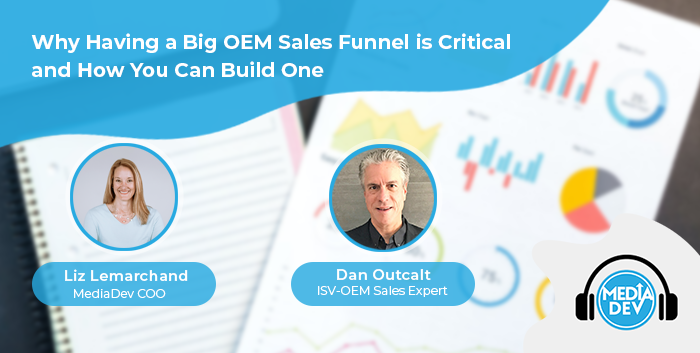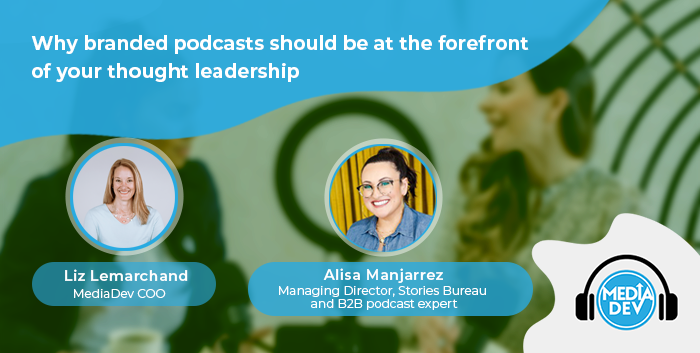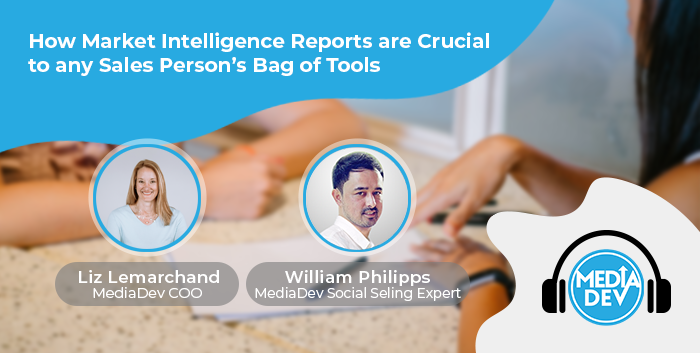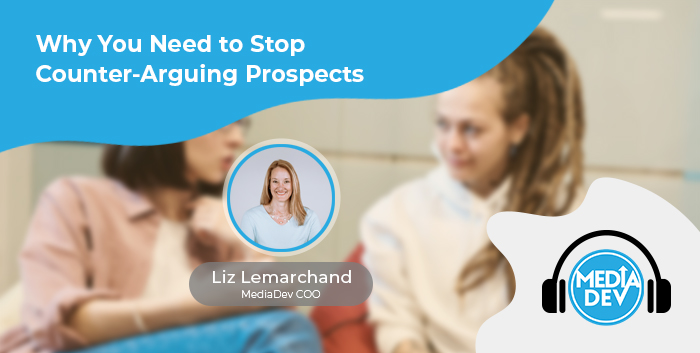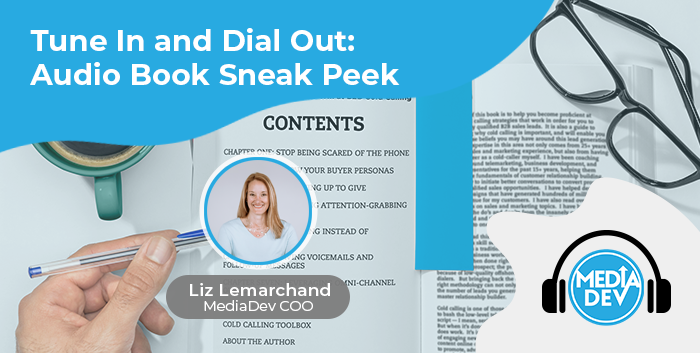Liz talks with Bernadette Wilson, ISV Content Writer for the DevPro Journal, and expert at content writing for software vendors. Learn as she shares tips on how to create B2B software content that’s engaging for your target buyer personas.
Listen to the episode on Anchor, Spotify, Breaker, Pocket casts, RadioPublic, or Google Podcasts. Or read the transcript below.
SHOW NOTES
- Why marketing content when it comes to software solutions is still often considered boring or dry? [00:40]
- Tips for collaborators/ people who review the writing [2:58]
- How can software marketers create more valuable content to engage their audience? [4:03]
- What types or formats of content are best for B2B software? [7:43]
- Why having good content is so important? [12:09]
- Recent trends about content marketing [14:42]
- Why is it hard for software vendors to get their heads around ISV-OEM? [18:00]
- Other tips for better B2B software content [21:37]
Listen to a previous episode with Bernadette Wilson where they discussed Creating Content for Independent Software Vendors (ISVs) here.
TRANSCRIPT
Liz Lemarchand: How is it that innovative software solutions have the ability to change the world yet they don’t sell themselves? How is it that I know my target market but I’m not able to generate enough sales opportunities? How do I even get started to create visibility for my brand when I’m not an expert in marketing? That is the question and this podcast will give you the answer. Welcome to SMplified: Software Marketing Made Simple!
Hey everyone, this is Liz from MediaDev and today I am joined by Bernadette Wilson who is an ISV content writer for the DevPro Journal and expert at content writing for software vendors.
Liz Lemarchand: Hi Bernadette, how are you today?
Bernadette Wilson: Hi I’m great. Thanks for having me.
Liz Lemarchand: It’s a pleasure and today’s topic for you today is how to create B2B software content that’s fun. Is it even possible? So, I love this topic Bernadette because so many people consider that marketing content when it comes to B2B software solutions is boring, it’s dry. So can you tell me why that is so often the case?
Bernadette Wilson: I think there could be a few reasons. First, I think that software vendors tend to focus on their technology when they write, and they have great technology and they want to share information about that. And that’s important. However, for the reader, they’re probably more interested in how it solves their problems or how they can use it to advance their businesses or even, you know, be a hero. It’ll come up with that way to make much more money with using the software.
So, I think that writing to the audience can make it a little more exciting, even for the writer. Instead of just repeating the speeds and feeds, and you know the basic technology things that people write about, it’s more interesting to show how it can work in the real world and solve people’s problems. Another reason is people who write for software companies tend to basically write the same things over and over.
I don’t mean exactly the same topic, but they’re writing about how a particular software works over and over or what a particular software does over and over. And at some point it just becomes repetitive, and that’s where it can get dry. The creativity kind of vanishes and you’re basically just writing, you know, repeating and cranking things out. And that that can make it boring for the reader.
It may be the 100th time that a writer has written about it, but it may be the first time that that reader is reading about it. So it’s important to do everything you can to keep that writing fresh. Another reason is that writing for software company is a very collaborative process and it needs to be and that can produce great results, but sometimes the collaborators want to keep things very controlled.
People who review the writing will refer constantly back to the style guide and kind of keep the writer in a box. And so the writer tends to always produce things that they know are safe. They won’t take any chances, use different vocabulary, try something new because they want the product to be something that the big person ultimately reviewing whether that’s the CMO or the CEO or the company will accept, so I think it’s important to give writers some latitude with what they can do.
It’s that try and fail kind of philosophy. It gives them some freedom and they may produce something great that it might not be something that’s in the style guide.
Liz Lemarchand: That’s a really great point! I especially love what you said about, you know this may not be the first time that they’ve written about this topic, but it may be the first time that the reader has read about the topic.
I think it’s really important to keep that in mind. Definitely agree with you on that. So how can B2B software marketers create more valuable content to engage their audience, and how can you make content in this space fun?
Bernadette Wilson: Well, as far as engaging the audience, it goes back to what I said before. You need to write to them that the content can’t be about you. It can’t be just about your business. It has to be about your audience. So if you know a typical persona that you want to grab the attention of in your target audience, that’s who you should be writing for, and that’s who you should be trying to engage.
I have a trick I learned it a long time ago. I actually have a picture from a magazine. It reminds me of someone I met at a trade show that is just a, you know, the quintessential, it’s actually a var from an ISV channel and I remember speaking with him and just the kind of person knowing the kind of person he was, how he talks things he’s interested in.
If you can write to that person, you’re going to have a better chance of engaging them with content than if you just write for the general population.
As far as making it fun, again, it kind of goes back to those things I said before you need to give yourself a little bit of freedom. I joke with people when they ask what I do for a living. You know when I’m at a luckily, fortunately back in person at events now talking to people and when I say I’m a writer, I think they immediately picture me with you know the jacket with the patches on the pockets were, sitting in New England somewhere, being inspired but I tell them now I’m a working writer, like I work every day, I write every day. But that tends to conflict, it’s in conflict with that idea of a creative writer. But you have to, you still have to let some of those creative impulses come out once in a while if you find an interesting word or turn of phrase, see if you can work it into your next blog, use it on social media, try new types of content that’s something else that we tend to get into with our assignments, we know that we do social once a week and we do blogs. We do two blogs a week. And or whatever your cadence is. But you once in awhile throw in content for an infographic or a short piece that you enhance with a little piece of video. It’ll help to make things a little more fun.
Back to collaboration, it’s much more fun if you could work with people that build you up rather than kind of put pressure on you to do things a certain way and again, we need to work within the guardrails right. We need to stay up. We need to stay on point. We need to stay within brand guidelines. All those things are important, but it’s it is important to have that freedom to try things and be a little creative from time to time, right?
Liz Lemarchand: Yeah, I love that. I always say you have to avoid the marketing blah blah which are the, you know, nice, very vague for you that don’t mean anything to anybody. So I love the tips that you’ve just cited just now, so that’s great. Thank you.
What types or formats of content do you think are the best as they relate to B2B? I mean you mentioned infographics and blogs, you know, are there other types of formats that you think are really critical to have as a B2B software?
Bernadette Wilson: Vendor case studies are gold. If you can get one of your users to talk about using your solution in the real world, how it solved their problems and the results that they get, that is great, storytelling is very effective. The person reading that who has a similar business will immediately understand why it’s important? What the value is? And giving that proof you know those numbers might not be representative of everyone in your user base, you know that they increased efficiency or they increased revenue, or they decrease costs, but for that one person it worked and so the reader would say you know I could do something similar that could have value to me as well. So that that’s great.
The problem with case studies though, is that you need to convince somebody to participate. So because it is an investment in time, they may have to take the finished product maybe, and run it through legal to make sure they’re not saying anything they can’t say so there’s a time element involved. But you can find people that will participate and it’s possible to incentivize them as well. It could be something as simple as a backlink. I just did one recently where the company was willing to put a back link to the users investment page, so that was a big incentive. We have to have that in there. We’d also joked with someone else, and I’m not sure they were joking. I think they were serious. They were giving gift cards for people that were participating, so it’s possible to incentivize people to give you the gift of their time and talk through this and work through the content with you.
The other thing that’s great about a case study is it’s one of those pieces of content that you can use over and over. You can cite it in a blog, build a blog around it. You can, if you record the interview that you do with the person you could use it as part of a podcast or insert it into a blog with some audio. You can certainly make a video if the person is willing to be recorded so that one story can give you a lot of mileage, and they can also, they’re also very effective.
Another idea that is really convenient for software developers, and it’s also effective is to maybe analyze data if you have that capability, you know not anything that would violate someone’s privacy, but just general user data and show if you can show other people in the market how they’re using it and the impact that they’re having with your software just right, it’s basically a little research report or study and that’s also something that will get the attention when you submit to magazines if you can show that you know you’ve done some research and then these are the numbers, that numbers seem to be a big hook when you submit so you know when you have proof of how something works. That’s also great fodder for an infographic when you can have the numbers do the graphical representations, the visualizations of that data, and then that’s great to use on social media, in your newsletters, really anywhere, because infographics will capture people’s attention.
Liz Lemarchand: I love that. And for us when we do content promotion and you know demand, generation or lead generation activities and we’re using content to help support those activities, we find very often that those two pieces of content, so case studies and infographics that you just mentioned, those are the two that are the most, you know, demanded by our audiences all the time. So definitely agree with you on those points.
So, I know this may sound kind of obvious, but you know, for some people at least you know why do you think having good content is so important.
Bernadette Wilson: Well, I looked at the stat. I mean I know I throw this around but I wanted to have the proof to back myself up. It’s from Google Research and a couple of years ago they did a study that found 58% of B2B manufacturing purchasers, and this is a particular group they start with online research before they follow up with the company so that I think that study was about three years ago, so and I doubt that the trend is losing steam. It’s easy to understand why it’s efficient if you’re a purchaser or a buyer, if you can go online and look at everybody that comes up in your keyword search for you know particular kind of software and you find them, and you look at their websites and you look at the description of the product or other information that they may have that their case studies or a demo that helps them work more efficiently. They’re not going to take a meeting or ask for a meeting with every single one of those companies, they’re going to say this one works for me. This one may or this one definitely doesn’t, so they can do their job more efficiently, more quickly, kind of that business is a little more easily, but what that means for you is if your content on your website isn’t up to par, if it doesn’t make an impression, if you aren’t clear in what you do, if you can’t capture the buyers attention, you’re not going to get that request for a call or a meeting. So it’s very important to have good content, that it not only talks about your product, it also talks about the problems it solves. It helps to give a buyer a little bit of a glimpse into your company culture, the kind of people you are because that’s important to people they want to work with people that they feel like it would be a pleasant relationship to have. And it’s also important to give them calls to action. What can I do next? Where can I get more information? And so it’s become an element of competitiveness.
How well you portray your business online, how well you convey information and capture buyers attention is ultimately going to make you more competitive. You’re going to be able to get more meetings, and hopefully close more sales.
Liz Lemarchand: Absolutely, I absolutely agree with everything that you just said. Yeah, so are there trends that you’ve observed recently about content marketing for B2B software vendors that are noteworthy? I mean, you kind of just mentioned, I mean I do agree with you that the buyers in general are, you know they’ve never been more informed and they never have had more access to information than before, but are there other trends that you think that you’ve observed that are really important in this space.
Bernadette Wilson: I have, one of the things is what we’re doing right now participating in a podcast the reason that I think is so important for a software development company is that you may not have the time or even the ability to launch your own podcast, but you can participate in others. You could find somebody that is focused on the same audience you are, you know to provide them with information. And see if you can be a guest or have some of your information discussed on that podcast.
But the reason that that’s important is, you know, just kind of what we talked about before, you don’t want to limit up your visibility. Just do a web search. You want to get your name out there even further. You expand your footprint. So if you can come get your brand in front of everybody that that podcast will reach, you’ve definitely elevated the number of people that will know about your business and it’s also a different type of content that you can use on social media.
You can share links again, people might be interested in that when they wouldn’t really get to know your business any other way. So I think that that’s a trend. It’s just really trying to expand the digital footprint that you have, and another trend is live broadcasting. LinkedIn live just began I think, a few months ago where you don’t have to pre record a video. You can actually just go on LinkedIn and share information and it’s getting some really good results I looked up the statistics for the same company when they do a LinkedIn live, they get 24 times more comments and seven times more reactions than other types of posts that they do on LinkedIn. So again, you’re reaching more people and just kind of offering up something that’s a little different, that’s probably another point that people are realizing that one size doesn’t fit all. Some people will search and read a blog. Some people will search and do a click on a demo. If you have a video demo some people like live presentations, some people like podcasts. They listen to them on their way to work so that it’s important to use everything that you can to get your brand in front of your target audience.
Liz Lemarchand: Oh yes, that is definitely true. So before we actually started our podcast, we were talking just a little bit about ISV OEM content, so looking to see if you could give us your opinion about that. Why do you think it’s hard for software vendors to get their head around ISV OEM?
Bernadette Wilson: I think that I was as we said before we started recording I as editor for Devpro Journal, I see a lot of things come through and they really vary you know, there’s such a variety, I think. That part of it is who you have writing? It could be someone in-house. We were just talking about all the different people that are generating content. So part of it is, I think, whether that writer has the capability, you know, to understand what they need to do. It’s also again it goes back to the audience that you’re writing for. Do you really have a grasp of what you need to the tone you need to take and what you need to say to capture that audience’s attention and that’s something that takes a while to develop, so if you’re using a new writer or maybe a service, it might take them a while that learning curve might be a little longer than you would like, but it does take people a while to grasp how to write for your audience and how to write about your solution.
Another thing is if you have people in-house, are you giving them enough time? A lot of people who have in-house writers have people who are good at writing, but they also have a full-time job that’s not writing, so it does take time to develop that voice and how you want to present the information. And if you’re only doing it maybe 1/2 hour every couple of days a week, it’s going to elongate that curve to proficiency to where you get the kind of content that you’d really like to present.
I’ve also noticed that, software developers aren’t necessarily writers, you know, they’re very creative.
Liz Lemarchand: That’s very true.
Bernadette Wilson: No, they you know they’re very good at what they do, but they aren’t necessarily comfortable, you know, they had to take the college composition course and that was it, just like, that’s enough. So it does help to collaborate and get other people feedback to be able to express what you want to express.
Liz Lemarchand: Yeah, yeah no. And I totally agree the quality really, you can tell, you know the difference in quality between somebody who really knows their audience and knows what they’re talking about, and somebody who may be a junior level person who doesn’t really know. I actually visited a blue chip software company website not very long ago and their OEM page literally said what is OEM and then it looked like a Wikipedia kind of copy paste stuff like original equipment manufacturer and I just kind of started laughing. And of course I was able to use that to pitch somebody within the company to, you know, tell them why they should think about modifying that, but are there any other tips that you’d like to give our audience today?
Bernadette Wilson: I would and it kind of follows from what we’ve been talking about. If you have a new writer, we’re working with a new company or you bring someone in-house that’s new, do what you can to encourage that person and nurture them. That’s something else that I’ve noticed is when a writer you know feels that freedom and they feel the support of their collaborative team and the people that are going to be reviewing their pieces, the quality is better, they’re more relaxed. They tend to grow into the position. Sometimes I think we can be super critical of people when they write and for whatever reason it’s just something that you can pick on. Know you said that wrong or but you know it does it does kind of weigh on someone after a while and as much as you can be encouraging, it really shows and I know that maybe seems counterintuitive intuitive, you know? Like where you know what you want to get somebody in line right away. But it’s better to help them along if you see someone with potential and you really want them to continue, be as encouraging as you can. I mean, there are ways to give criticism without being, you know, without insulting me but definitely give them pointers for how to make things better, and you can’t let something go out that’s wrong, so definitely correct it, but just be encouraging, you know and it will show. I mean, I’ve seen that with people I’ve worked with. It does help them to grow into the position and to produce that quality content that you need.
Liz Lemarchand: So do you want to give a quick plug for the Devpro Journal before we wrap it up today?
Bernadette Wilson: Yeah, great, that would be great. We are an online magazine for ISVs and software developers and we have a little bit of information on the types of tools you use, news from the industry, but our primary focus is to help you grow your business so we’re always looking for new opportunities. People that see new trends are willing to comment on that, ways to work more efficiently, and through the pandemic, you know how to deal with a newly remote team. And now we’re working on how to bring them back. We transition people back, things of that nature. We also have a lot of guidance for startups and we occasionally get this story. The great story about how someone succeeded and we share that as well. So come check us out devprojournal.com, and hopefully you’ll find something that can help you advance your business and operate a little more how you would be able to market a little better. That’s another topic that we include. So yeah, we’d love to have you visit the site and possibly sign up for the newsletter.
Liz Lemarchand: Super yes, and of course I’ve given submissions to the Dev Pro Journal as well, so you can check out some of those submissions there and other resources on the MediaDev Library at mediadev.com. So thanks again, Bernadette for your time today. Really appreciate it.
Bernadette Wilson: Oh, thanks for having me. Thanks so much.
Liz Lemarchand: You just listened to simplified brought to you by MediaDev. If you have software marketing questions or need help marketing your software solution, reach out to us at contact@mediadev.com and check out other amazing assets for you on our resource library at mediadev.com.



